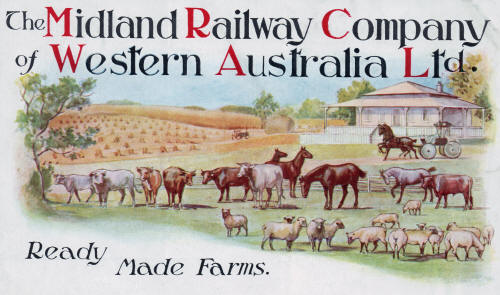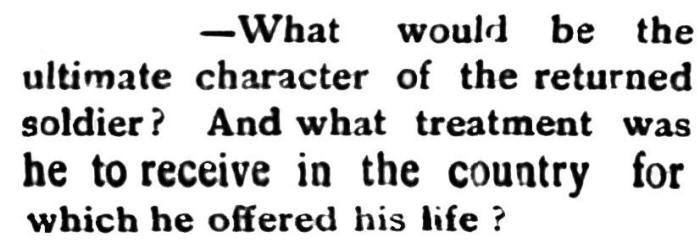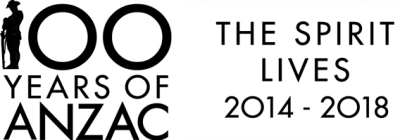First World War
Virtual Museum : Macpherson ●
Railway ●
Farms ●
Schools ●
Power ●
Roads ●
Business ●
Milk ●
Tea ●
Post ● Books ●
Toys
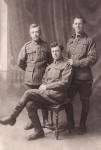
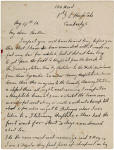
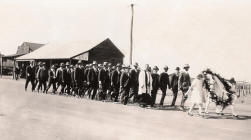
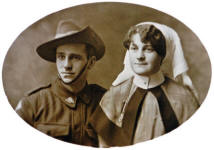
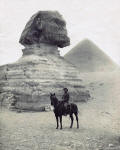
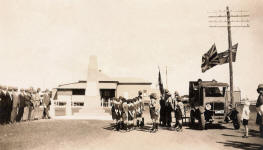
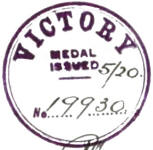
Carnamah was a thinly populated and little known place when war was
declared in 1914. The Macpherson family had been
in the district for over 45 years, a few others families for about a
decade and the first settlers to take up
Ready-Made Farms had just arrived. Despite the small population, 38 men enlisted from the
district and ten were killed in action.
This virtual exhibition looks at six soldiers from the North
Midlands who lived in Carnamah before or after the war.
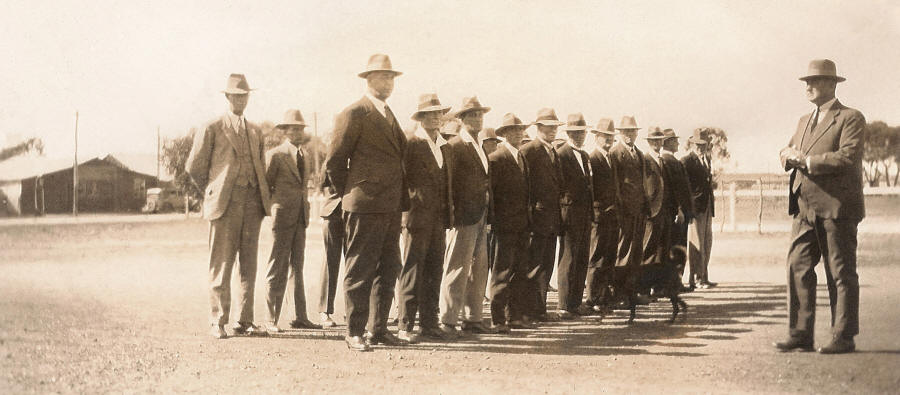
Right: Alick MacLean
Carnamah had a small one-teacher school which was under the management of 25 year old Scottish immigrant Alick MacLean. An Education Department inspector described him as "Inexperienced but eager to improve. A Good Teacher."
He was granted leave in 1914 to enlist in the Australian Imperial Force (A.I.F.). He was 6 feet ¾ inches tall, weighed 74 kilograms and had blue-grey eyes, light brown hair and a fair complexion.
Alick landed with the 12th Battalion on the Gallipoli Peninsula in Turkey on 25 April 1915. One of his comrades thought he was shot, possibly in the arm, and headed for the beach. Whatever did happen, he died and was never seen again.
Carnamah had a small one-teacher school which was under the management of 25 year old Scottish immigrant Alick MacLean. An Education Department inspector described him as "Inexperienced but eager to improve. A Good Teacher."
He was granted leave in 1914 to enlist in the Australian Imperial Force (A.I.F.). He was 6 feet ¾ inches tall, weighed 74 kilograms and had blue-grey eyes, light brown hair and a fair complexion.
Alick landed with the 12th Battalion on the Gallipoli Peninsula in Turkey on 25 April 1915. One of his comrades thought he was shot, possibly in the arm, and headed for the beach. Whatever did happen, he died and was never seen again.
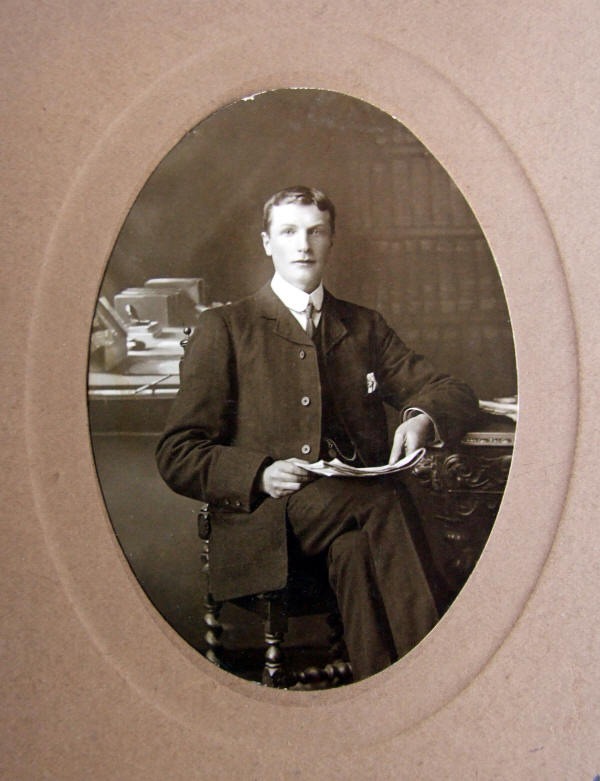
Left: Ready-Made Farms advert
Jack Colpitts, an English farmer from South Africa, purchased and settled on a Ready-Made Farm in Winchester. Within a year of his arrival he had enlisted in the A.I.F. and left Australia for active service abroad. He served in the 10th Light Horse Regiment and various other units, rising to the rank of Major.
Jack Colpitts, an English farmer from South Africa, purchased and settled on a Ready-Made Farm in Winchester. Within a year of his arrival he had enlisted in the A.I.F. and left Australia for active service abroad. He served in the 10th Light Horse Regiment and various other units, rising to the rank of Major.
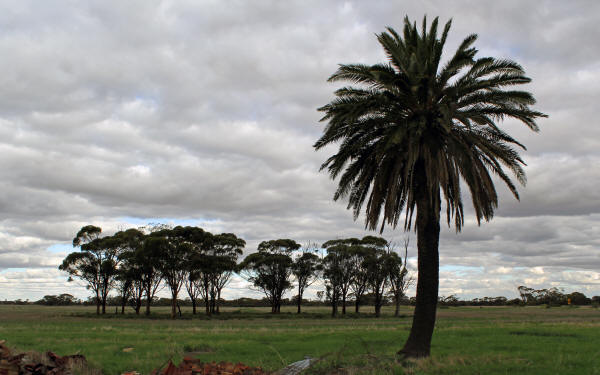
During the Major's absence his wife
Mrs Susan Colpitts ran their farm,
supplemented its income by undertaking contract fallowing and
harvesting, and worked tirelessly raising funds for the Red Cross.
Jack returned and the site of their former home is strikingly marked by a palm tree on The Midlands Road between Carnamah and Coorow.
Jack returned and the site of their former home is strikingly marked by a palm tree on The Midlands Road between Carnamah and Coorow.
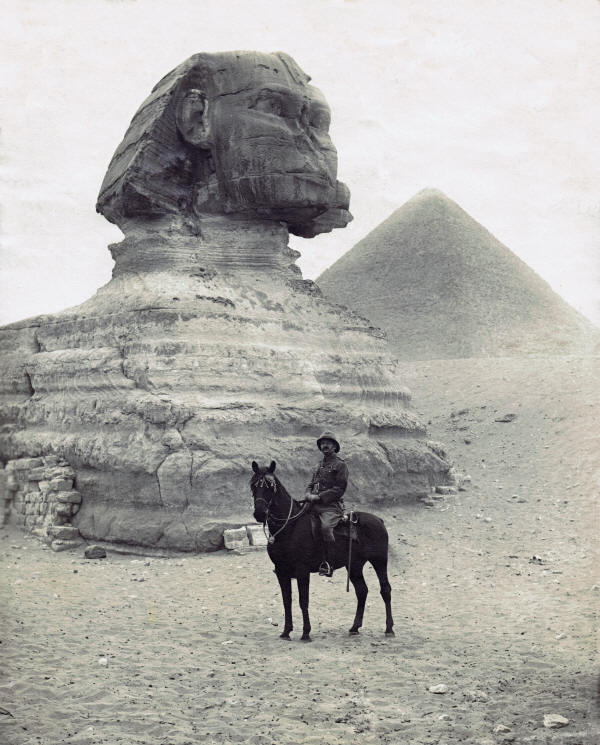
Left: Jack Colpitts at the
sphinx in Egypt
"An enjoyable evening was spent recently at the home of Mrs J. W. Colpitts, Winchestrer, in aid of the 10th Light Horse Trench Comfort League. About £8 was collected. Miss Colpitts sported the 10th L.H. colours and sold dainty little sweets. A number of people came from Three Springs, Carnamah and Coorow to enjoy the evening. Mr Charlie Maley was the justice and Mr Honner the prosecutor in the mock court. Several gentlemen were fined for being over the age of 25 and not married. The birthday of Captain Colpitts, who is still in France, was honoured."
- The Sunday Times newspaper on 16 December 1917
"An enjoyable evening was spent recently at the home of Mrs J. W. Colpitts, Winchestrer, in aid of the 10th Light Horse Trench Comfort League. About £8 was collected. Miss Colpitts sported the 10th L.H. colours and sold dainty little sweets. A number of people came from Three Springs, Carnamah and Coorow to enjoy the evening. Mr Charlie Maley was the justice and Mr Honner the prosecutor in the mock court. Several gentlemen were fined for being over the age of 25 and not married. The birthday of Captain Colpitts, who is still in France, was honoured."
- The Sunday Times newspaper on 16 December 1917
Christopher Hoskyns-Abrahall was a Major in the Royal Marine Light
Infantry. He retired after 23 years and migrated to Western
Australia, where he also purchased a Ready-Made Farm at Winchester.

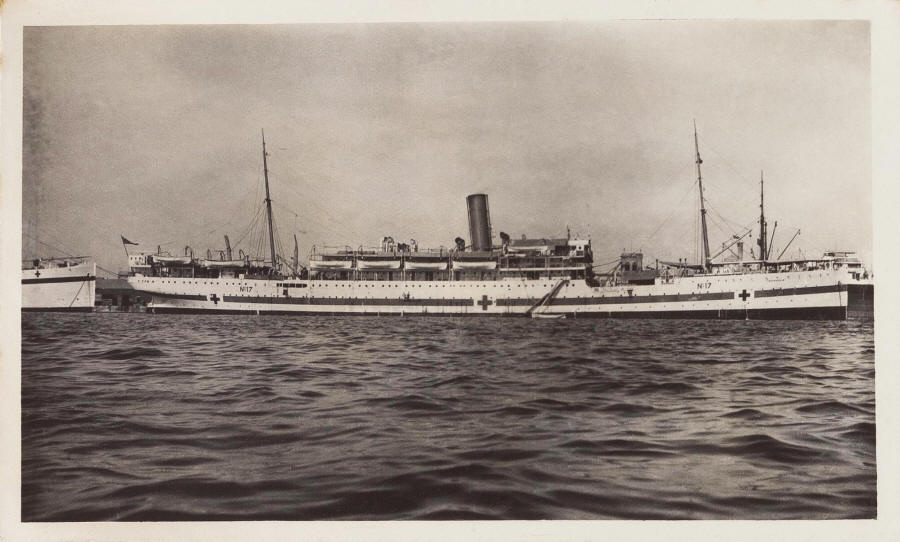
Above: The hospital ship Dongola,
on which Major Hoskyns-Abrahall died
Following the outbreak of war, Major Hoskyns-Abrahall helped raise the Australian Imperial Force’s 16th Battalion in Perth but then returned to England and re-enlisted in the marines. He lead a gallant attack on the Gallipoli Peninsula in Turkey on 3 May 1915, which was credited with allowing the safe return of Australians who had been driven out of their trenches. However, he was wounded during the attack and died the following day. He was one of 1,023 Western Australians who died as a result of the Gallipoli campaign.
Following the outbreak of war, Major Hoskyns-Abrahall helped raise the Australian Imperial Force’s 16th Battalion in Perth but then returned to England and re-enlisted in the marines. He lead a gallant attack on the Gallipoli Peninsula in Turkey on 3 May 1915, which was credited with allowing the safe return of Australians who had been driven out of their trenches. However, he was wounded during the attack and died the following day. He was one of 1,023 Western Australians who died as a result of the Gallipoli campaign.
Left: Plaque at Kings Park in
Perth
Aeneas Murray grew up in Gingin and before enlisting worked as a railway fettler in Carnamah for the Midland Railway Company.
He enlisted in the A.I.F. in 1915 and served as a Private in the 11th Infantry Battalion in France. He was hospitalised after being shot in the left buttock and another three times due to illness and trench fever. He died on 31 July 1918 after suffering a shell wound to his head and a fractured skull.
Olive Parkin of Carnamah, who was a close friend or perhaps something more, wrote to the A.I.F. requesting a photograph of his grave.
His headstone at the Borre British Cemetery in northern France reads: "One who helped to write Australia's history in blood."
Aeneas Murray grew up in Gingin and before enlisting worked as a railway fettler in Carnamah for the Midland Railway Company.
He enlisted in the A.I.F. in 1915 and served as a Private in the 11th Infantry Battalion in France. He was hospitalised after being shot in the left buttock and another three times due to illness and trench fever. He died on 31 July 1918 after suffering a shell wound to his head and a fractured skull.
Olive Parkin of Carnamah, who was a close friend or perhaps something more, wrote to the A.I.F. requesting a photograph of his grave.
His headstone at the Borre British Cemetery in northern France reads: "One who helped to write Australia's history in blood."
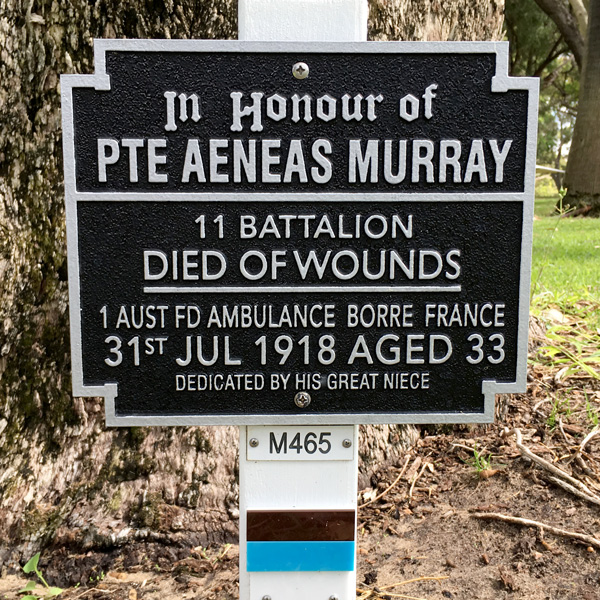
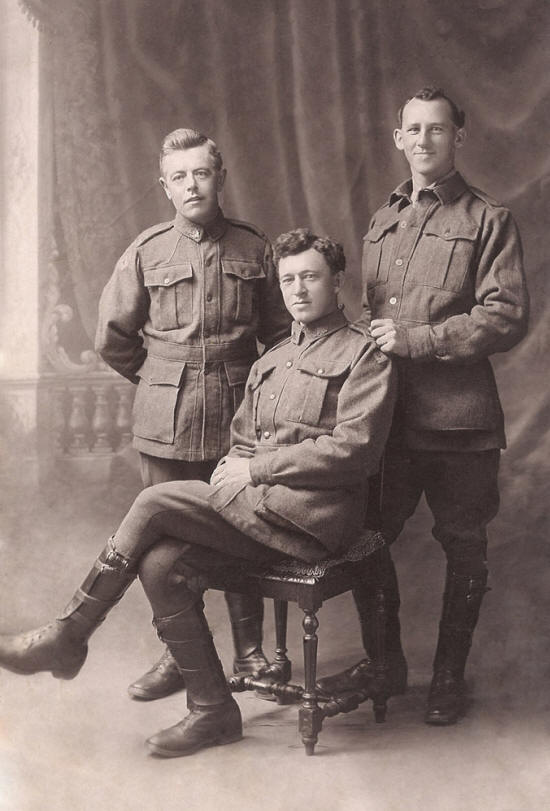
Right: Ned Wells (seated)
Ned Wells, who grew up in Bindoon and Wannamal, was employed to drive a horse-drawn butcher’s cart between Three Springs and Arrino.
His initial attempt to enlist in the A.I.F. was rejected because of his poor eyesight. He persevered and his second attempt proved successful. He served with the 3rd Pioneer Battalion in France.
Just before active service, Ned sent a card from France to his sister, in which he wrote: “And long before you receive this I will be playing my part, but don’t worry dear sister, with God’s aid I will come through.”
Below: Ned's card to his sister, signed with nickname of Johnny
(click + drag to zoom / navigate image)
Ned Wells, who grew up in Bindoon and Wannamal, was employed to drive a horse-drawn butcher’s cart between Three Springs and Arrino.
His initial attempt to enlist in the A.I.F. was rejected because of his poor eyesight. He persevered and his second attempt proved successful. He served with the 3rd Pioneer Battalion in France.
Just before active service, Ned sent a card from France to his sister, in which he wrote: “And long before you receive this I will be playing my part, but don’t worry dear sister, with God’s aid I will come through.”
Below: Ned's card to his sister, signed with nickname of Johnny
(click + drag to zoom / navigate image)
Right: Ned Wells
Ned returned to Three Springs after the war and later took up farming in Carnamah. At times he was unable to work for entire days due to problems with his eyes, which had been aggravated by his war service. He was financially ruined by the Great Depression and left with no option but to abandon his farm. He worked locally as a farm manager for a few years and then with his wife Peg ran the Wells & Wells Pyramid Tea & Dining Rooms. The remaining portion of their tearooms is now our museum.
Ned was a member and avid supporter of the Returned & Services League (R.S.L.) and in 1994 received a 50-year Service Award. He remained in Carnamah and Three Springs for the remainder of his life and died at the age of 103 in 1996.
Below: Ned's A.I.F. discharge certificate from 1919
(click + drag to zoom / navigate image)
Ned returned to Three Springs after the war and later took up farming in Carnamah. At times he was unable to work for entire days due to problems with his eyes, which had been aggravated by his war service. He was financially ruined by the Great Depression and left with no option but to abandon his farm. He worked locally as a farm manager for a few years and then with his wife Peg ran the Wells & Wells Pyramid Tea & Dining Rooms. The remaining portion of their tearooms is now our museum.
Ned was a member and avid supporter of the Returned & Services League (R.S.L.) and in 1994 received a 50-year Service Award. He remained in Carnamah and Three Springs for the remainder of his life and died at the age of 103 in 1996.
Below: Ned's A.I.F. discharge certificate from 1919
(click + drag to zoom / navigate image)
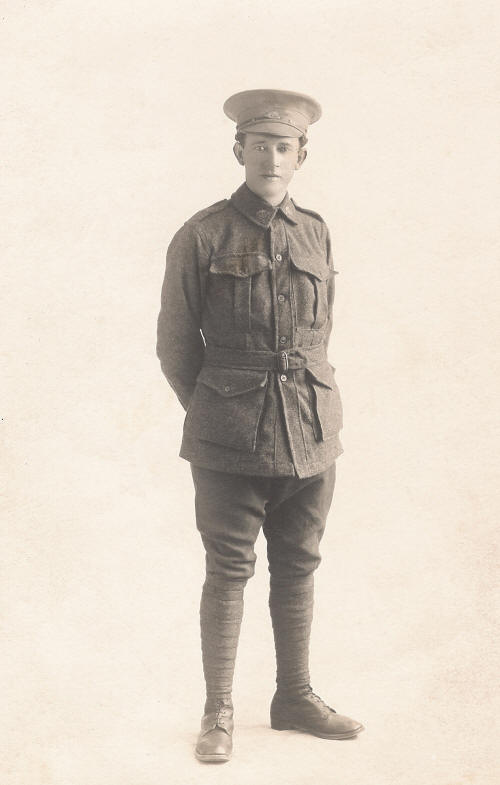
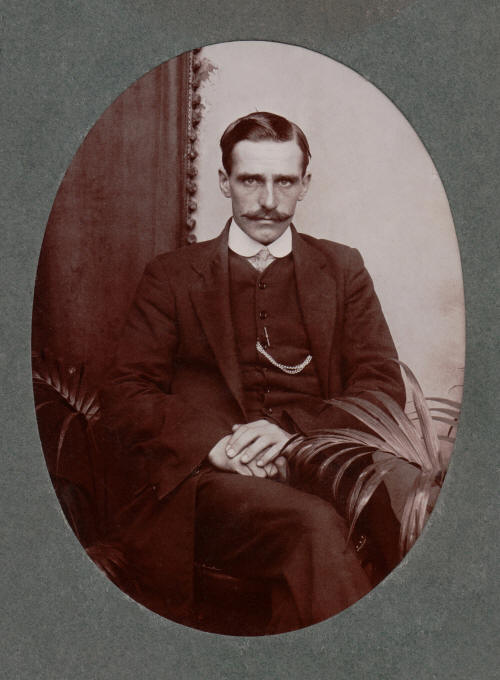
Roger Clark had migrated from England with his parents and worked as a farmhand in Mingenew and Dongara. He enlisted in the A.I.F. in 1915 and saw service with the 28th Battalion in both Gallipoli and France. After receiving multiple gunshot wounds he was evacuated to England.
Following an operation to remove shrapnel, Roger remarked in a letter to his mother:
“as soon as I came round I looked down to see if I had still got my leg and great to my relief it was still there.”
During his recovery in England he was cared for by a nurse named Dobbie Rumble. They married in 1917 and after the war she returned with him to Western Australia.
Roger out of uniform (left) and Dobbie with a recovering Roger (below)
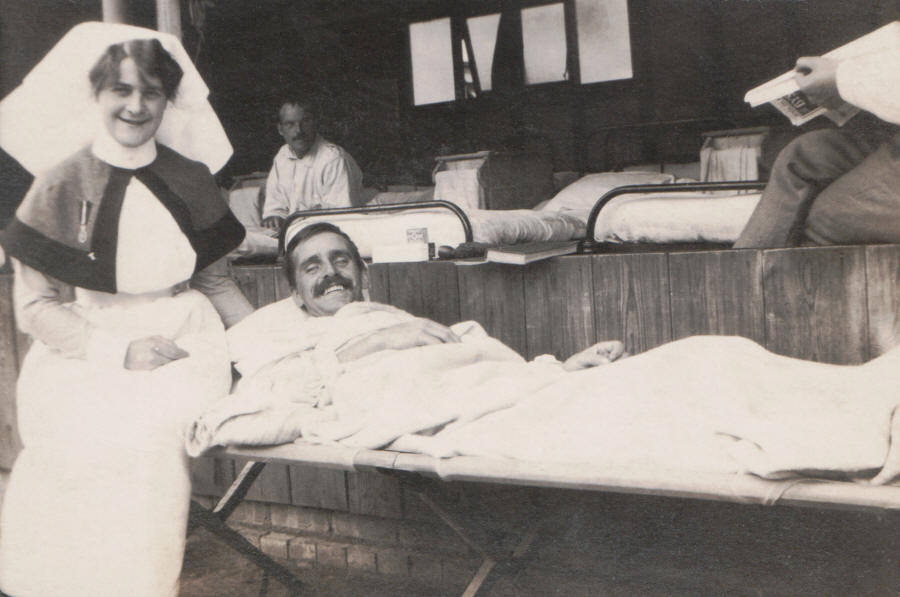
The Repatriation Department wrote to Roger's former employer requesting
he be reinstated or offered another job if he was less capable: “It is unnecessary, I feel sure, to stress the obligation which
rests upon all employers to co-operate with the Government in
re-establishing in civil life, on the best terms possible, the men
who have risked so much at the call of their country.”
However, five years had passed and much had changed. His former employer had died during the war and his employer’s widow had discontinued farming.
However, five years had passed and much had changed. His former employer had died during the war and his employer’s widow had discontinued farming.
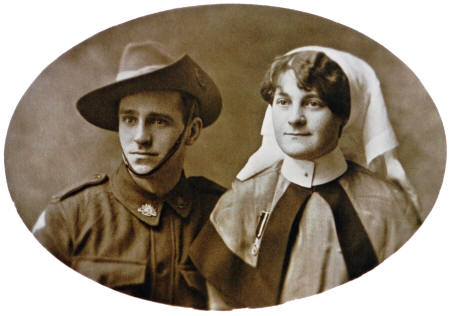
From 1915, when wounded soldiers began returning home, the government
held concerns about how to transition them back into the workforce.
One of the
solutions was the Soldier Settlement Scheme whereby larger properties
were purchased, subdivided and offered to returned men
at discounted interest.
Below: One of four soldier settlement estates in the Carnamah district
Below: One of four soldier settlement estates in the Carnamah district
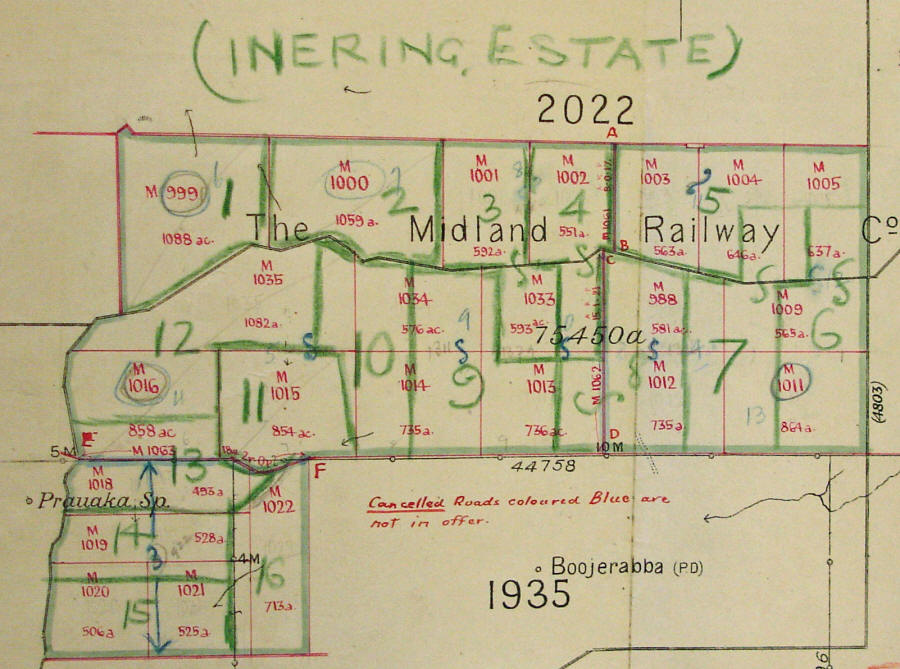

Roger Clark became one of 40 ex-servicemen to take up a solider settlement farm in Carnamah. He farmed locally for 35 years but other soldier settlers were unable to remain so long. These included Roy Timmings who died from meningitis after a grass seed got stuck in his ear, Jack Spork who had to walk off his farm at the outset of the Great Depression, and Herbert Murray who died of complications from war injuries. Others lost land due to rising salinity or sold up as their farms proved too small.
Below: Harvest by both tractor and horse-power on Roger's Rosebury Row Farm in Carnamah
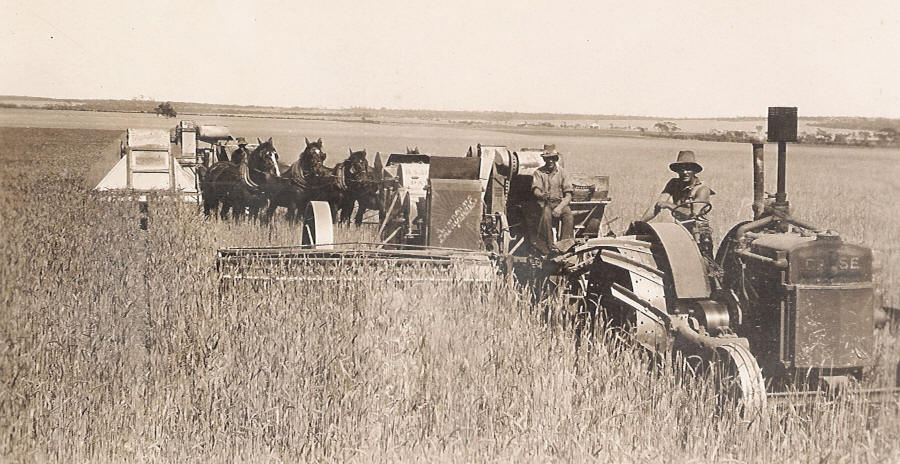
“All our efforts during the war were concentrated upon the raising
of funds on behalf of the various schemes to alleviate in some measure
the terrible sufferings and privations of our gallant soldiers, who went
forth to fight for home and freedom, covering themselves with
imperishable glory in the great struggle.” – Carnamah farmer
John Lang at the opening of the
Carnamah Hall in 1921
Below: Anzac Day march to the unveiling of the Carnamah War Memorial on 25 April 1929
Below: Anzac Day march to the unveiling of the Carnamah War Memorial on 25 April 1929
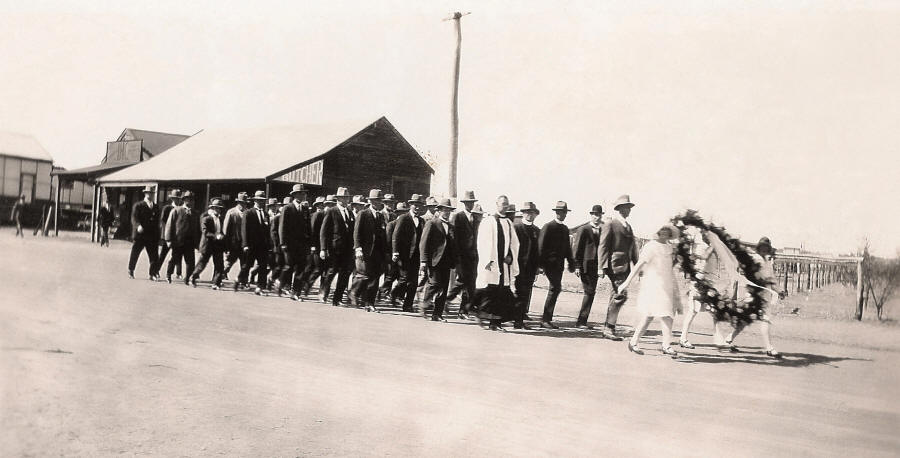
Killed in Action
Enlistments from Carnamah and Winchester
● Sydney Brooks
● Christopher Henry Hoskyns-Abrahall
● James Keenan
● Herbert Vincent Larkin
● Alexander MacLean
● Aeneas Murray
● Edward Harvey Statham
● Charles William Ewart Vernede
Returned to Australia
Enlistments from Carnamah and Winchester
● "Noel" Edward Noel Bell
● Michael Bohan
● "Jack" John Watson Colpitts
● John Ernest Crampton
● "Frank" Francis Cornelius Crook
● John Davern
● "Jack" Reginald McWhinney Diamond
● "Syd" Sydney Edwards
● James King Forrester
● Ernest Joseph Hayes
● John Henry Jebb
● "Lou" Louis Johansen
● Archibald Lang
● John Lang
● William Hepburn Lister
● Bert William Long
● William Scott Mitchell
● "Bill" William McLaren Newman
● Howard Cecil Okes
● "James" William James Cunningham Ramsay
● William George Read
● "Frank" John Frank Sewell
● James Neville Ewart Vernede
Soldier Settlers - Yarra Yarra Estate
Purchased from Donald Macpherson
● Maurice Ethelbert Cook
● "Tom" Thomas Garth
● "Jack" Peter John Lynch
● "Oscar" Frank Oscar Malmgreen
● Irwin Samuel Moore
● George Sharp
● "Roy" Lewis Roy Timmings
● "Anster" Anstruther Pavy Tucker
Enlistments from Carnamah and Winchester
● Sydney Brooks
● Christopher Henry Hoskyns-Abrahall
● James Keenan
● Herbert Vincent Larkin
● Alexander MacLean
● Aeneas Murray
● Edward Harvey Statham
● Charles William Ewart Vernede
Returned to Australia
Enlistments from Carnamah and Winchester
● "Noel" Edward Noel Bell
● Michael Bohan
● "Jack" John Watson Colpitts
● John Ernest Crampton
● "Frank" Francis Cornelius Crook
● John Davern
● "Jack" Reginald McWhinney Diamond
● "Syd" Sydney Edwards
● James King Forrester
● Ernest Joseph Hayes
● John Henry Jebb
● "Lou" Louis Johansen
● Archibald Lang
● John Lang
● William Hepburn Lister
● Bert William Long
● William Scott Mitchell
● "Bill" William McLaren Newman
● Howard Cecil Okes
● "James" William James Cunningham Ramsay
● William George Read
● "Frank" John Frank Sewell
● James Neville Ewart Vernede
Soldier Settlers - Yarra Yarra Estate
Purchased from Donald Macpherson
● Maurice Ethelbert Cook
● "Tom" Thomas Garth
● "Jack" Peter John Lynch
● "Oscar" Frank Oscar Malmgreen
● Irwin Samuel Moore
● George Sharp
● "Roy" Lewis Roy Timmings
● "Anster" Anstruther Pavy Tucker
Soldier Settlers - Carnamah Estate
Purchased from the Midland Railway Company
● "Noel" Edward Noel Bell
● Roger Wyman Clark
● "Jack" John Joseph Cullen
● Harry Leonard Denslow
● "Harry" Harold Frank Dunning
● "Zeb" Zebulun Green
● Frank Thomas Patrick Heuston
● "Tom" Thomas Johnston
● Malcolm Munro McSwain
● "Bill" William McLaren Newman
● "Jack" Johan Christian Spork
● John Martin Tully
Soldier Settlers - Winchester Estate
Purchased from Louis Patrick Parker
● Irwin Roy Cousins
● George Frederick Bailey Dixon
● Arthur White
● "Tom" Walter Thomas White
Soldier Settlers - Inering Estate
Purchased from Arthur Garfield Darling
● Lot 1 - "Bill" William Joseph Langdon
● Lot 2 - Frank Lucas
● Lot 3 - "Joe" Joseph Balmer
● Lot 4 - George Catto
● Lot 5 - George Frederick Salter
● Lot 6 - Campbell William Bean
● Lot 7 - "Dick" Claude Richard Batty
● Lot 8 - "Bill" William Walter James Price
● Lot 9 - Vidal Fitzgerald Jackson
● Lot 10 - "Jack" John Frame
● Lot 11 - "Any" Andrew Smith Cumming
● Lot 12 - "Don" Donald Ferguson Cumming
● Lot 13 - "Jack" John Edward Iles
● Lot 14 - "Charlie" Charles Banwell Dodd
● Lot 15 - "Lou" Louis Johansen
● Lot 16 - "Harry" Herbert Murray
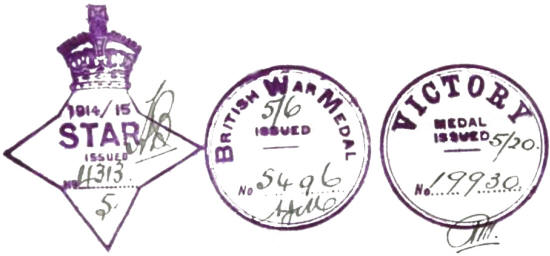
Purchased from the Midland Railway Company
● "Noel" Edward Noel Bell
● Roger Wyman Clark
● "Jack" John Joseph Cullen
● Harry Leonard Denslow
● "Harry" Harold Frank Dunning
● "Zeb" Zebulun Green
● Frank Thomas Patrick Heuston
● "Tom" Thomas Johnston
● Malcolm Munro McSwain
● "Bill" William McLaren Newman
● "Jack" Johan Christian Spork
● John Martin Tully
Soldier Settlers - Winchester Estate
Purchased from Louis Patrick Parker
● Irwin Roy Cousins
● George Frederick Bailey Dixon
● Arthur White
● "Tom" Walter Thomas White
Soldier Settlers - Inering Estate
Purchased from Arthur Garfield Darling
● Lot 1 - "Bill" William Joseph Langdon
● Lot 2 - Frank Lucas
● Lot 3 - "Joe" Joseph Balmer
● Lot 4 - George Catto
● Lot 5 - George Frederick Salter
● Lot 6 - Campbell William Bean
● Lot 7 - "Dick" Claude Richard Batty
● Lot 8 - "Bill" William Walter James Price
● Lot 9 - Vidal Fitzgerald Jackson
● Lot 10 - "Jack" John Frame
● Lot 11 - "Any" Andrew Smith Cumming
● Lot 12 - "Don" Donald Ferguson Cumming
● Lot 13 - "Jack" John Edward Iles
● Lot 14 - "Charlie" Charles Banwell Dodd
● Lot 15 - "Lou" Louis Johansen
● Lot 16 - "Harry" Herbert Murray

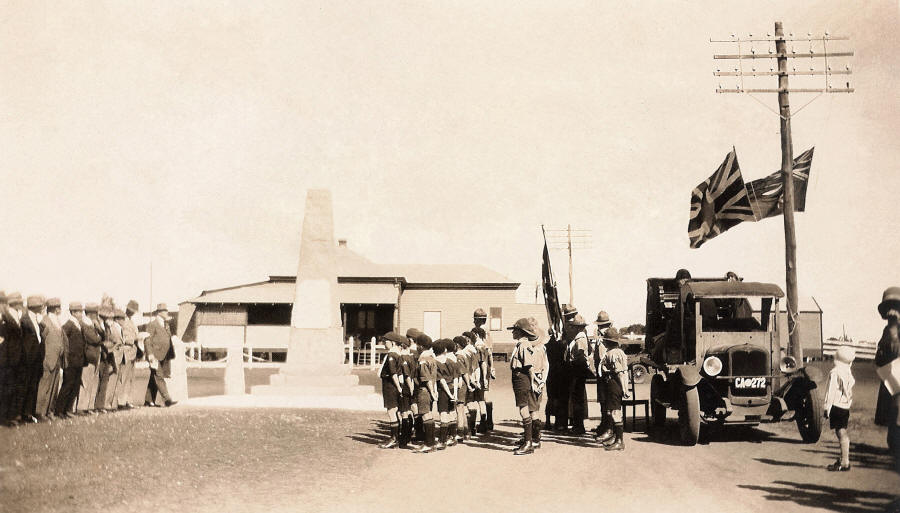
V i r t u a l M u s e u m :
Macpherson ● Railway ● Farms ● Town ● Schools ● Roads ● Business ● Milk ● Electricity ● Tearooms ● Post ● Books ● Toys
Now featuring 10863 Bushranger presented by Act Belong Commit





